 Edward VII Drinking Fountain, W. S. Frith.
Edward VII Drinking Fountain, W. S. Frith.
 Edward VII Drinking Fountain, W. S. Frith.
Edward VII Drinking Fountain, W. S. Frith.
This monument is close to Whitechapel tube station opposite the hospital, in the midst of a busy market. It consists of a granite obelisk, which broadens towards the base and contains the shelves and basins and steps needed to form a drinking fountain, with several sculptural adornments. On the front, facing outwards to the street, is a medallion with a profile portrait of Edward VII, in high relief, surrounded by a border of stylised bluebells, and with a crown on top. A similar medallion on the opposing side bears the legend: 'In grateful and loyal memory of Edward VII, Rex et Imperator, Erected by subscriptions raised by Jewish inhabitants of East London, 1911’: the whole area, of course, has much history connected with the Jewish community.
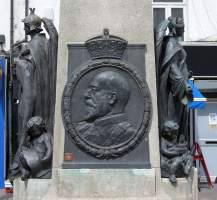
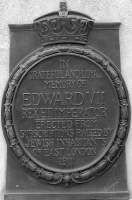
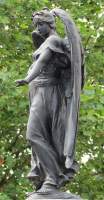
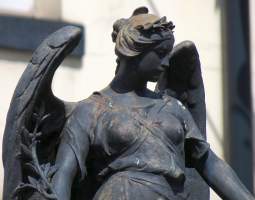 Portrait, inscription, summit figure.
Portrait, inscription, summit figure.
On the top is a summit figure, a graceful standing female angel, with a swirl of skirt around the feet, standing with her arms out from her sides, one gesturing or blessing downwards, the other holding an olive branch indicative of peace, and a circlet of olive leaves is in her hair. On each side of the monument is a further group consisting of an angel with two infants, or cherubs, at her feet and beneath, a winged cherubic head as a tap. The one walks on broken shackles, and holds a charter with a seal, and perhaps a flower. She wears a crown, and a heavy cloak pinned across her front and draped Roman fashion over one forearm. The younglings at her feet hold a ship and motor car respectively. She is Liberty. On the other side is Justice, carrying her scales across one arm, her heavy sword standing up to her shoulder, her helm with a tiny figure on top. A very good figure, this one, with muscular frame and determined look. (More figures of Justice, and a short discussion, on this page.) The infants carry a book and a scroll.
The figures on the monument are not large, but from the base of the obelisk to the top of the crowning angel’s head must be about 14 or 15 ft. Larger would feel disproportionate to the location. The angels are elegant, feminine, naturalistic and filled with movement in the way those sculptors who were sometimes classed together as the ‘New Sculpture’ movement excelled at. Their hair is short, bound up and Edwardian, and there is much of art nouveau about these figures – again the hair, the hem on the Justice figure, the style of the angels’ wings, the poise and grace of the hands, and the flow of the drapery over shoulder and breast and arm.
The sculptor of this splendid work was W. S. Frith, one of the less familiar sculptors of the period. His significance to British sculpture was as a teacher, and he was not able to devote himself to practicing his art as much as his colleagues and pupils. Much of what he did produce was architectural sculpture, most notably his allegorical figures and other decoration for nos.13-15 Moorgate, in the City. More details of his other works on his page. For now, it is interesting to compare these Moorgate figures with the Edward VII ones: the Moorgate ones are from 15 years or more earlier, and while there are some aspects which are similar – the build of the women, the liking for detail and a baroque swirliness to the drapes, the Moorgate figures feel Victorian while the Edward VII ones are unmistakably of the Edwardian era. 1911 was towards the end of the peak of such things, for then came the Great War, and after a brief flowering in the production of some of the war memorials up to as late as 1921 or so, the style was to vanish, kept on only in the works of some illustrators, recreating for children’s books and adventure stories the recollection of an art nouveau world which had vanished.
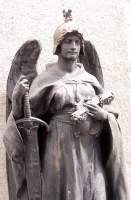
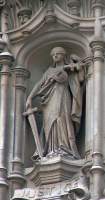 Close up of Justice, and Frith's earlier Justice in Moorgate.
Close up of Justice, and Frith's earlier Justice in Moorgate.
Drinking fountains were a common feature in the cities from mid-Victorian times, some commemorative like this one, but rather more due to the efforts of the Metropolitan Drinking Fountain and Cattle Trough Association, founded in 1859, and smaller, more local organisations outside London often linked to the Temperance movement: the provision of free, clean water, it was hoped, would help wean the disadvantaged of society off their liquor. A typical small obelisk fountain, eastwards from Whitechapel, is against the railings of Christ Church Spitalfields (and illustrated on the page on this site dedicated to that church); and there are many modest fountains, often in red granite, which still survive, waterless, around London – one fairly close by, to Leonard Montefiore, is by the Stepney Green Clock Tower. Large memorial fountains include the Buxton Memorial Fountain by the Houses of Parliament, and the enormous Readymony fountain in Regent’s park, which happily gives forth water through some modern touch-sensitive mechanism which is a pleasure for passers-by to discover.
There are many old buildings and some sculpture to discover in the neighbourhood of the Edward VII fountain. Eastwards and south down Stepney Green is a short walk not just to the clock tower mentioned above, with two sculptured panels, but then on to St Dunstan's Stepney, an important medieval church with monuments. Westwards and northwards leads to Christ Church Spitalfields, a Hawksmoor church with two important monuments (and a simple obelisk fountain outside), and going further leads to Shoreditch Town Hall, with some architectural sculpture, and St Leonard’s Shoreditch, with a variety of smaller panel monuments.
Another memorial to Edward VII featured on these pages is the Edward VII Memorial in Northampton.
Previous month (August 2012) // Next month (October 2012)
Sculptors // Sculpture in London
Visits to this page from 13 Mar 2014: 10,899